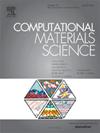The magnetism of two-dimensional non-magnetic borides Mo2B2 induced by doping and adsorption
IF 3.3
3区 材料科学
Q2 MATERIALS SCIENCE, MULTIDISCIPLINARY
引用次数: 0
Abstract
To explore the magnetic properties of two-dimensional non-magnetic borides Mo2B2 and expand their applications in the field of spintronics, we investigate, based on first-principles calculations, the electronic structures and magnetic properties of Mo2B2 monolayers doped and adsorbed with transition metal (TM = V, Cr, Mn, Fe, Co, Ni) atoms. The results show that both TM-doped and TM-adsorbed Mo2B2 monolayers retain metallic properties. Specifically, the Cr-, Mn-, and Fe-doped Mo2B2 monolayers exhibit ferromagnetism, with magnetic moments of 1.35 μB, 1.92 μB, and 0.97 μB, respectively. Similarly, when Cr, Mn, Fe, and Co atoms are adsorbed onto the Mo2B2 monolayer, these systems also display spin polarization, with magnetic moments of 2.37 μB, 1.70 μB, 1.81 μB, and 1.37 μB, respectively. The ferromagnetism primarily originates from the exchange splitting of the d-orbit of these transition metal atoms. The adsorption of TM atoms on Mo2B2 monolayer can induce stronger magnetism than doping. Finally, the positive magnetic anisotropy energies (MAE) of Cr/Mn/Fe-doped and Cr/Mn-adsorbed Mo2B2 monolayers indicate in-plane magnetization direction, while the negative MAE of Fe and Co atoms adsorbed on Mo2B2 monolayers demonstrate that the magnetization direction tends to be perpendicular to the plane. The MAE of Mn- and Fe-doped Mo2B2 monolayers have relatively high values of 7130 μeV and 7990 μeV. Our study provides valuable guidance for experimental work.

掺杂和吸附诱导二维非磁性硼化物Mo2B2的磁性
为了探索二维非磁性硼化物Mo2B2的磁性,并扩大其在自旋电子学领域的应用,我们基于第一性原理计算,研究了掺杂和吸附过渡金属(TM = V, Cr, Mn, Fe, Co, Ni)原子的Mo2B2单层的电子结构和磁性。结果表明,掺杂tm和吸附tm的Mo2B2单层膜均保持了金属性质。其中,Cr、Mn和fe掺杂的Mo2B2单层膜表现出铁磁性,其磁矩分别为1.35 μB、1.92 μB和0.97 μB。同样,当Cr、Mn、Fe和Co原子吸附在Mo2B2单层上时,这些体系也表现出自旋极化,磁矩分别为2.37 μB、1.70 μB、1.81 μB和1.37 μB。铁磁性主要来源于过渡金属原子d轨道的交换分裂。TM原子在Mo2B2单分子膜上的吸附能产生比掺杂更强的磁性。最后,Cr/Mn/Fe掺杂和Cr/Mn吸附的Mo2B2单层的正磁各向异性能(MAE)表明磁化方向是平面内的,而吸附在Mo2B2单层上的Fe和Co原子的负磁各向异性能(MAE)表明磁化方向是垂直于平面的。Mn掺杂和fe掺杂的Mo2B2单层膜的MAE分别为7130 μeV和7990 μeV。本研究为实验工作提供了有价值的指导。
本文章由计算机程序翻译,如有差异,请以英文原文为准。
求助全文
约1分钟内获得全文
求助全文
来源期刊

Computational Materials Science
工程技术-材料科学:综合
CiteScore
6.50
自引率
6.10%
发文量
665
审稿时长
26 days
期刊介绍:
The goal of Computational Materials Science is to report on results that provide new or unique insights into, or significantly expand our understanding of, the properties of materials or phenomena associated with their design, synthesis, processing, characterization, and utilization. To be relevant to the journal, the results should be applied or applicable to specific material systems that are discussed within the submission.
 求助内容:
求助内容: 应助结果提醒方式:
应助结果提醒方式:


